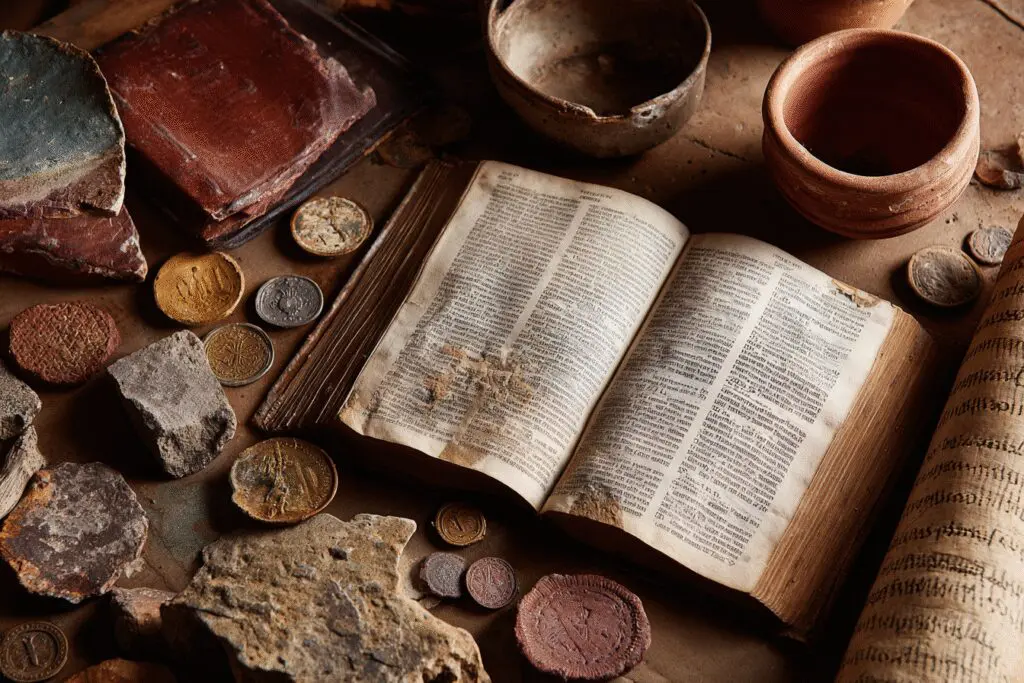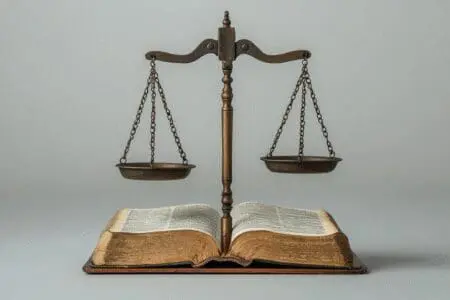I hit my 30s and realized something unsettling. I had spent the last decade building a career, figuring out relationships, and trying to keep a fiddle-leaf fig alive, but I’d completely neglected the big questions. The kind of questions you push aside in your 20s because you’re too busy.
Suddenly, they were staring me right in the face. I had all these inherited beliefs and secondhand opinions, but I didn’t have a clue what I actually thought for myself. So, I started a little project. I decided to really look into the things I’d always just accepted or dismissed, and the Bible was at the top of the list. My goal wasn’t to become a scholar; it was simply to answer one question honestly: What is the strongest evidence that the Bible is trustworthy?
This isn’t a sermon. It’s not an academic paper. It’s just the log of my journey, one guy trying to sort through the noise and find something solid. What I found genuinely surprised me.
More in Bible Category
What Is the Truth About the Bible
What Does the Bible Say About Itself
Why Is the Book of Nephi Not in the Bible
Key Takeaways
Before we dive in, here’s the short version of what I found most compelling. For me, the evidence stacks up in a few key areas:
- The Manuscript Flood: The sheer number of ancient Bible manuscripts absolutely dwarfs any other book from the ancient world. It’s not even a close competition.
- Dirt and Digs: Archaeology keeps digging up people, places, and events that critics once claimed were biblical fiction. The ground itself is confirming the book’s historical accounts.
- The Unlikely Blueprint: The Bible’s internal consistency—written by 40 authors over 1,500 years on three continents—is statistically staggering. It tells one unified story against all odds.
- Telling the Future: It contains hundreds of specific, detailed prophecies about people, cities, and nations that were verifiably fulfilled centuries after they were written.
- The Life Test: Ultimately, the most powerful evidence was seeing how its teachings, when actually applied, radically change lives for the better—including my own.
Okay, But Where Do You Even Start With Something This Big?
Honestly, my first real attempt to read the Bible was a disaster. I felt completely overwhelmed. It felt like trying to assemble a massive piece of furniture with a thousand-page manual written in a language I barely understood. There were genealogies, ancient laws, and poetry that went right over my head. I put it down, convinced it was impenetrable.
My mistake was trying to swallow it all at once.
So, I took a different approach. I decided to step back from the spiritual claims for a minute and treat it like any other historical document. Before I could ever consider what it says about God, I needed to know if it was reliable history. Could I trust the words on the page to be what the original authors actually wrote? And were those authors talking about real things that happened in the real world?
That simple shift in perspective gave me a starting point. It turned an overwhelming spiritual quest into a manageable historical investigation.
Is It Just a Faded Old Copy of a Copy?
The first thing that always bugged me was the “game of telephone” argument. I remember playing that game in elementary school. One kid whispers a sentence to the next, and by the time it gets to the end of the line, “My dog has fleas” has turned into “The frog has cheese.” It’s funny in a classroom, but it’s a scary thought if you’re trying to trust a 2,000-year-old book. I just assumed that the Bible had been copied so many times over the centuries that we couldn’t possibly know what it originally said.
It turns out, that assumption is completely wrong.
I learned there’s a whole science dedicated to this called textual criticism. In simple terms, scholars reconstruct original texts by comparing all the ancient manuscript copies we have. The more copies you have, and the earlier they are, the more confident you can be about the original wording. When you make a typo in an email, you can compare it to the original in your head to fix it. With ancient texts, scholars compare thousands of copies to spot and correct any scribal errors that crept in over time.
This is where the evidence for the New Testament just goes off the charts.
- We have over 5,800 full or partial Greek manuscripts of the New Testament.
- If you add in manuscripts in other ancient languages (like Latin, Coptic, and Syriac), that number jumps to over 24,000.
- Some of our earliest fragments date to within just a few decades of the original writings. The John Rylands fragment, a piece of the Gospel of John, is dated to around 125 A.D., maybe only 30-40 years after John wrote it.
Now, let’s put that in perspective. What’s the second-best-preserved book from antiquity? That would be Homer’s Iliad. We have about 1,900 manuscripts of the Iliad. The earliest copy we have was made 400 years after Homer wrote it. For most other ancient works, like those by Plato or Aristotle, we have only a handful of manuscripts, often dating from 1,000 years or more after the original.
No other ancient book comes even remotely close to the New Testament in terms of the number of manuscripts and how early they are. The conclusion is that we can be incredibly certain that the New Testament we read today is what the original authors wrote. The game of telephone argument just doesn’t hold up to the evidence.
Did Any of This Stuff Actually Happen? Digging for Proof.
Okay, so we know what the originals said. But were the authors writing history or fiction? This was the next big hurdle for me. It’s one thing to have an accurate copy of The Hobbit, it’s another thing to believe Hobbits are real.
I’ve always been a history buff. I love visiting museums or old battlefields—seeing an object or a place you’ve only read about in a book makes it feel real and tangible. I wanted to see if that same kind of physical evidence existed for the Bible.
This is where archaeology comes in, and the findings are stunning. For a long time, skeptics dismissed huge parts of the Bible, especially the Old Testament, as myth because there was no independent evidence for certain people or places. Then, we started digging. And we keep finding things that line up perfectly with the biblical text.
Here are just a few examples that I found compelling:
- The “Mythical” Hittites: The Old Testament mentions the Hittite empire over 40 times. For centuries, there was zero archaeological evidence that they ever existed, and critics used this as proof that the Bible was just making things up. Then, in the early 1900s, archaeologists unearthed their capital city, their records, their entire civilization. The Bible was right all along.
- King David’s “House”: A major point of skepticism was the existence of King David. Many scholars claimed he was a figure of myth, like King Arthur. But in 1993, archaeologists discovered a stone inscription, the Tel Dan Stele, dating to the 9th century B.C. It was created by an enemy king who boasted of his victory over the “king of Israel” and the “House of David.” It was the first extra-biblical reference to David’s dynasty, and it was a bombshell. You can explore more about discoveries like the Dead Sea Scrolls on university research pages, like this one from the University of Chicago.
- Pontius Pilate: We all know him from the Gospels as the Roman governor who sentenced Jesus to death. For a long time, there were no records of him outside the Bible. Then, in 1961, a stone was found in Caesarea Maritima bearing an inscription from “Pontius Pilate, Prefect of Judea.”
The list goes on and on—Hezekiah’s Tunnel, the Pool of Siloam, the house of Peter the apostle, the high priest Caiaphas’s ossuary. Time and again, archaeology has shown that the biblical writers were grounded in reality. They knew the geography, the culture, and the political figures of their day. This doesn’t prove the miracles, of course, but it shows that these were sober-minded accounts of real events, not fairy tales.
How Could 40 Different Guys Write One Coherent Story?
This next piece of evidence is more of an internal, logical one, but it’s just as powerful.
I once tried to write a simple project proposal with three other guys at work. We were all in the same room, on the same day, with the same goal. It was a complete mess. By the end of the day, the document was full of contradictions, different tones, and competing ideas. It was nearly impossible to get four people to agree on one short document.
Now, consider the Bible.
- It was written over a span of about 1,500 years.
- It has around 40 different authors.
- These authors were from all walks of life: kings, shepherds, fishermen, a doctor, a prophet, a tax collector.
- They wrote in three different languages (Hebrew, Aramaic, and Greek).
- They wrote on three different continents (Asia, Africa, and Europe).
- They wrote in different literary styles: history, poetry, law, prophecy, letters.
Many of these authors never met each other. They lived in different centuries and different cultures. By all logic, the result should be a chaotic, contradictory jumble of religious texts.
But it’s not.
Instead, the Bible tells one single, continuous, and consistent story from beginning to end. It starts in a garden (Genesis) and it ends in a city with a garden (Revelation). The plot is the same all the way through: a good world that gets broken by human rebellion, and a God who initiates a grand rescue plan to redeem and restore it. The themes of sacrifice, redemption, and covenant are woven throughout. The promises made in the earliest books are shown to be fulfilled in the later books.
It’s a single, unified narrative. The odds of this happening by chance are, frankly, zero. It’s like finding 40 different authors from the last 15 centuries, who all wrote one chapter of a novel without consulting each other, and having it come out as a perfectly coherent bestseller. The best explanation for this incredible consistency is that there was one single, ultimate Author guiding the whole project.
What About the Fortune-Telling Part? (And I Don’t Mean Horoscopes)
I’ve always been a skeptic. If someone told me they could predict who would win the World Series next year, I’d want to see some proof. So when I heard the Bible was full of prophecies, my guard went up immediately. I was thinking of vague, horoscope-style predictions that could mean anything.
But biblical prophecy is different. It’s specific, it’s detailed, and it’s documented.
The Old Testament contains hundreds of prophecies about future events that were fulfilled in detail. The key here is that we know, thanks to manuscript evidence like the Dead Sea Scrolls (which predate Jesus by more than a century), that these prophecies were written down long before the events they describe. This isn’t someone writing history and pretending it’s the future.
Here are a couple of powerful examples:
- The Fate of Tyre: In the book of Ezekiel, chapter 26, the prophet gives an incredibly specific prediction about the destruction of the powerful coastal city of Tyre. He says many nations will come against it, the city’s stones and timber will be thrown into the sea, and the site would be scraped clean like a bare rock, never to be rebuilt. The first part was fulfilled by King Nebuchadnezzar of Babylon. But he only destroyed the mainland city. The people of Tyre moved to an island fortress offshore. It seemed like a failed prophecy. But 250 years later, Alexander the Great arrived. To conquer the island, he scraped up all the rubble, timber, and stones from the old mainland city and used it to build a causeway out to the island. He literally threw the old city into the sea and scraped the site clean, just as Ezekiel had predicted. The original site remains a bare rock to this day.
- The Messiah’s Resume: The Old Testament contains over 300 prophecies about the coming Messiah. These aren’t vague. They specify his lineage (from Abraham, Isaac, Jacob, and David), his birthplace (Bethlehem), his betrayal for 30 pieces of silver, the fact that his hands and feet would be pierced, and that he would be crucified with criminals, all hundreds of years before Jesus was born. The odds of one person fulfilling even a handful of these by chance are astronomically small.
This is evidence that’s hard to dismiss. It points to a source of knowledge that exists outside of our normal timeline.
So, It’s Old and It’s Consistent. But Does It Actually Work?
After looking at all this external evidence—the manuscripts, the archaeology, the prophecy—I was intellectually convinced. The case for the Bible’s historical reliability is rock-solid. It’s not a book of myths or fairy tales. It’s a document firmly grounded in history.
But I’m a practical person. I can read the specs and history of a car engine all day, but the real test is getting behind the wheel. Does it actually drive?
That’s the final and, for me, most important question. Does the Bible work? Do its teachings, when put into practice, actually make a positive difference in a person’s life? This is where the evidence moved from historical to personal. This is where I had to stop being an investigator and start being a test subject.
I’d spent years struggling with a low-grade anxiety that I couldn’t shake. The advice I usually got from culture was to look inward, to practice self-love, to focus on me. It was all about self-help. But the more I looked inward, the more I found a tangled mess.
The Bible’s advice was completely counter-intuitive. It told me to look outward and upward. It told me that peace doesn’t come from fixing my circumstances, but from trusting something bigger than my circumstances. Passages like Philippians 4, which talks about replacing anxiety with prayer and gratitude, or Matthew 6, which says not to worry about tomorrow, started to sink in. I began to practice it. When I felt that familiar knot of anxiety, instead of spiraling inward, I’d try to turn it into a prayer or find something to be thankful for.
It wasn’t a magic pill. The problems didn’t disappear. But my perspective on them completely changed. The weight started to lift. It was the first time I felt a sense of peace that wasn’t tied to whether my life was going well.
The Ultimate Test: My Own Life
Looking back, the journey has been a process of layers. It started with a simple, skeptical question. The manuscript evidence showed me the text is secure. The archaeological evidence showed me the context is real. The internal consistency and fulfilled prophecy showed me something supernatural was at play.
Each of those layers built a compelling case.
But the strongest evidence that the Bible is trustworthy? For me, it has been the change in my own life. It’s seeing its principles produce good fruit—patience where there was frustration, hope where there was cynicism, and purpose where there was just a daily grind. It’s not about becoming perfect overnight. It’s about having a reliable blueprint for life, a moral compass that actually points true, and a source of strength that doesn’t run out.
The external evidence is what gets you to the front door. It gives you the confidence to turn the knob. But it’s only when you step inside and live in the house that you know, without a doubt, that it’s real. For me, the strongest evidence isn’t found in a dusty scroll or an archaeological dig site. It’s in a changed heart. And that’s an experience you can’t argue away.
Frequently Asked Questions – What Is the Strongest Evidence That The Bible Is Trustworthy

How does fulfilled prophecy serve as evidence of the Bible’s trustworthiness?
Fulfilled prophecies, especially those about Jesus and ancient cities, demonstrate that the Bible’s predictions came true in detail. This accuracy suggests a divine knowledge behind the text, thereby supporting its trustworthiness.
What archaeological discoveries support the Bible’s historical reliability?
Archaeological finds such as the stone mentioning the ‘House of David,’ Hezekiah’s tunnel, and the tomb of Caiaphas confirm the existence of biblical people and places. These discoveries show that the Bible reflects real historical events and locations.
Do differences in Bible manuscripts affect its core message?
Most differences in manuscripts are minor, such as spelling errors or word order changes, which do not affect the main Christian beliefs. These small variations are comparable to typos and do not alter the essential message of the Bible.
How close are the earliest biblical copies to the original texts?
Many of the earliest copies of the New Testament were made within a few decades of the original writings, making them very close in time. For example, parts of the Gospel of John date to just a few decades after it was written, similar to finding a historical document from a recent century, which reduces the chance of story alterations.




